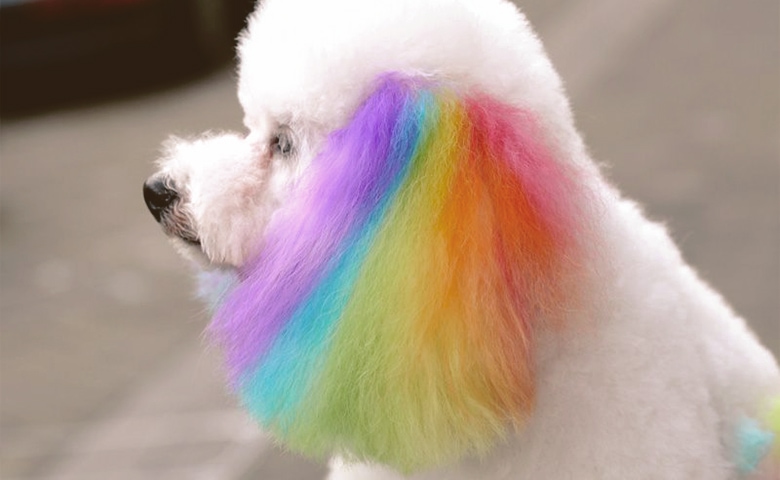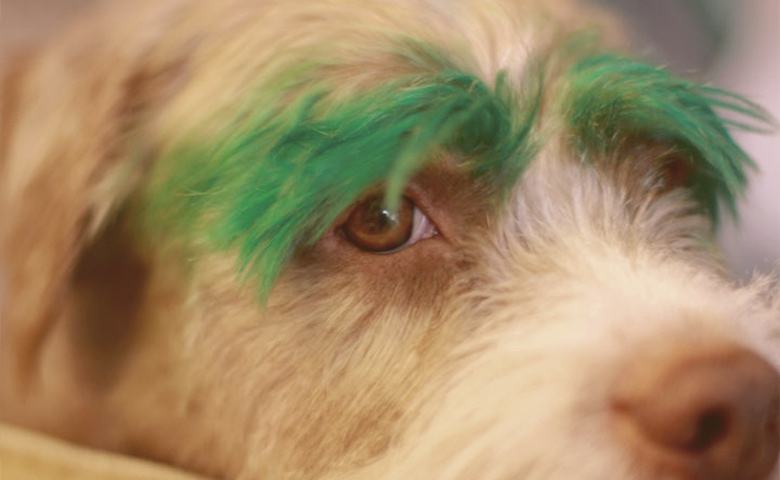There was a big fad in China a few years back where people were dying their pets to look like wild animals such as tigers and pandas. In North America, it is not unusual to see dogs died to accompany children on Halloween or as part of a statement such as Breast Cancer Awareness Month, when many dogs go pink for a month. Is it safe to dye your dog? Is it cruel? Is it legal?
In some states it is illegal to dye your pet with dog hair dye. These laws were generally enacted to protect small animals around Easter time but can also be applied to normal pets. Some people have been fined for dyeing their dogs.
Whether it’s cruel or not, depends on your pet. Some animals, such as small rodents like rats, mice, and chinchillas, should never be dyed. You don’t bathe them because they get chilled easily and are very vulnerable to illnesses like pneumonia. Dyeing them just puts them at risk of illness and is extremely stressful for them. Cats are also seldom bathed and tend to find it very stressful. Cats are also serious groomers and have many food sensitivities not present in dogs and people. So, dyeing your cat is not a great idea either.
Dyeing your dog can be safe and cause no harm if done right. For starters, your dog is not a good candidate for dyeing if they hate being bathed. Dogs that are groomed regularly are usually quite used to being bathed and it causes no unusual distress in them. If you are going to dye your dog’s fur, it is important to use the right dye. Human dyes are not meant for ingestion and are very toxic. Always remember that anything you put your dog is likely to be consumed when they lick their fur. Also, their fur tends to cover their whole body, making skin exposure to the dye significantly higher than it is when you dye your own hair.
Choose a pet-safe dye (there are some on the market) or better still use food colouring which is very safe when eaten. You can also use Kool Aid. Be careful to avoid getting any dye in your pet’s eyes. The first time you apply a dye, put it only on a small patch of fur and then wait 24 hours. This is to make sure your dog is not allergic to any aspect of the dye. A small patch of itchy skin is much kinder than a whole body itch. If your dog suffers from any type of skin disorder or condition that causes skin irritation, it is better not to try to dye their fur.
There have been no long term studies of the effects of dyes, including the pet safe dyes, on an animal’s health so use it with some caution. Be aware of your dog’s personality as well. Taking your shy little dog and dying him to look like a panda is going to attract a lot of attention. He may not appreciate that and find the whole experience stressful.
As long as your dog does not mind the dyeing process or the resultant attention, it is not harmful to dye your dog. It is important you use the right kind of dyes to avoid making your pet sick. You should never dye pets like cats, rats, mice, and chinchillas. To dye an animal that will find the procedure stressful is cruel. The rest is up to you.
How to Safely Dye Your Dog

While most states do not have explicit laws against the dyeing of dogs, there are some activists and groups who stand vehemently opposed to the practice.
Dyeing, especially when not practiced correctly, can damage the animal and cause serious health issues.
These issues vary from case to case and animal to animal, but reactions to dye are hard to predict.
If you choose to dye your dog, it is best to visit a reputable groomer and have it done there.
They will have specialized dyes made for dogs to reduce the risks and dangers, as well as the knowledge to avoid common mistakes.
Taking some additional time to find licensed groomers with animal dye will help protect your pet.
Otherwise, if you are attached to dyeing your dog yourself, there are some dangers to know and avoid.
Contents Table of ContentsPawsInsider Table of ContentsTitle: Table can only be rendered in frontend.

The majority of states do not have laws governing the specific dyeing of dogs.
In fact, most states only have laws making the dyeing of chicks and rabbits illegal.
The dyeing of dogs becomes a factor depending on the wording of these laws.
At the same time, some states are explicit in banning dyeing only for certain animals; others extend protections to many creatures.
This may not be an exhaustive list, and it is mainly up to interpretation.
Most dog owners who dye their pets have no issues, but depending on how law enforcement reads the law, they could give you a hard time.
Use your judgment in combination with the information provided here.
A summary and excerpt of various state laws governing the use of animals for things like prizes and dyeing can be found here for easy access.
As expected, most of these laws specifically discuss chickens, other fowl, and rabbits, but the language may not clearly allow dogs to be dyed.
Other resources that you may be interested in:

Colorado is one state with a history of fining groomers who have dyed their pet, although it is rare.
In Colorado’s wording of the law, the dyeing of all animals is illegal, making it a clear-cut case.
A salon owner in Boulder, Colorado faced charges back in 2009, bringing this old law to light.
By the letter of the law, dyeing your dog is illegal in Colorado.
However, many salons still offer the service throughout the state, and cases, where fines are handed out, are extremely rare.
Most citizens seem to agree that the law is antiquated, but that does not change the situation’s legality.
In the case mentioned above, the salon owner who dyed her poodle pink did not have to pay fines but was ordered to no longer dye animals or risk further action.

Maine’s laws surrounding the dyeing of animals are similar to Colorado’s; the legislation specifies that the dyeing of any animal that will be sold, shown, raffled, or given away is illegal.
Most dog owners do not have to worry about this, but there is a chance that law officials could be sticklers about it.
If you are showcasing your dog in public while dyed, it may be illegal under the “shown” clause.
Although this original wording was almost certainly intended for shows and official events, the language is unclear enough that there could be an argument against normal dyeing.
As such, it is best to exercise caution when dyeing your dog in Maine.
While problems are not expected, as most people are okay with dyeing dogs, it cannot hurt to be careful.
Can Dye My Dog Cause Him Allergies?
Even if your chosen dye is dog-friendly and non-toxic, there is still the possibility that your dog is allergic to it. A professional dog groomer will know how to detect if your dog has this type of allergies.
If so, it is better to resort to other safer alternatives, such as vegetable dye. Never dye your dog’s hair with human hair dyes!
Remember that dogs do not have the same PH as your skin. For this reason, you cannot use human shampoo on dogs either.
Dyeing your dog fur with safe fruits is the best option. The juice from the real fruits will provide a hint of color, which is not safe for your dog’s fur and skin. You can simply squeeze the juice or take help from a food processor or blender to extract the juice properly.
List of safe fruits for dogs:
All-natural organic food colors are the best when you wish to dye your dog in a vibrant color. India Tree Nature’s Colors are semi-permanent plant-based colors, which easily comes off in 4-5 washes. Make sure you use a small quantity and do a patch test first before going heavy handed on the colors.
Temporary dog fur dyes are great as they are not stubborn and come out easily in 2-3 wash or they fade within a few weeks. Warren London Critter Temporary Color is easy to use as they don’t require to be mixed with water. You can simply apply the color using a brush, spray bottle or fingers and leave it to dry. These color once dry fully will not come off or ruin your furniture or clothes.
Washable pet fur chalks are safe and non-toxic to use on your pet as well as on your own hair. Willbon Temporary Washable Pet Chalk is water-soluble and is easily comes off using a pet shampoo, which reviewed here. You also get a variety of bright colors that will look stunning on your dog.
FAQ
Is it animal abuse to dye a dog?
Is it OK to dye your dog’s hair?
Can you dye your dog’s hair in Colorado?